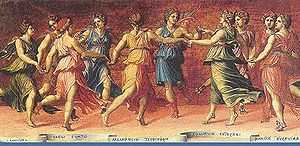Baldassare Peruzzi
| Baldassare Peruzzi | |
|---|---|
 Baldassare Peruzzi, Muses Dancing with Apollo | |
| Birth name | Baldassare Tommaso Peruzzi |
| Born |
7 March 1481 Siena, Italy |
| Died |
6 January 1537 (aged 55) Rome |
| Nationality | Italian |
| Field | Painting, Architecture |
| Movement |
High Renaissance Mannerism |
| Works |
Decoration of Villa Farnesina Palazzo Massimo alle Colonne |
Baldassare Tommaso Peruzzi (7 March 1481 – 6 January 1536) was an Italian architect and painter, born in a small town near Siena and died in Rome. He worked for many years with Bramante, Raphael, and later Sangallo during the erection of the new St. Peter's. He returned to his native Siena after the Sack of Rome (1527) where he was employed as architect to the Republic. For the Sienese he built new fortifications for the city and designed (though did not build) a remarkable dam on the Bruna River near Giuncarico. He seems to have moved back to Rome permanently by 1535.
He was a painter of frescoes in the Cappella San Giovanni (Chapel of St. John the Baptist) in the Duomo of Siena.
His son Giovanni Sallustio was also an architect.
Design and decoration of Villa Farnesina
Almost all art critics ascribe to him the design of the Villa Chigi in Rome, now known more commonly as the Villa Farnesina. In this villa, two wings branch off from a central hall with a simple arrangement of pilasters, and a decorative frieze on the exterior of the building . The frescoed paintings which adorn the interior rooms are for the most part by Peruzzi. One example is the Sala delle Prospettive, in which Peruzzi revived the perspective schemers of Melozzo da Forli and Mantegna, possibly under the influence of both. The walls the room are painted so that when one stands toward the left, one has the illusion that one is standing in an open-air terrace, lined by pillars, looking out over a continuous landscape. The decoration of the façade, the work of Peruzzi, has almost entirely vanished, but it is documented in a drawing by an anonymous French artist in the New York Metropolitan Museum of Art . To decorate this villa on the Tiber many artists were employed, and just as the style of the villa in no wise recalls the old castellated type of country-house, so the paintings in harmony with the pleasure-loving spirits of the time were thoroughly antique and uninspired by Christian ideas. Raphael designed the composition of the story of Amor and Psyche as a continuation of the Galatea. On a plate-glass vault Peruzzi painted the firmament, with the zodiacal signs, the planets, and other heavenly bodies. The interior room has a striking use of illusionistic perspective
Other work
Peruzzi had produced for the church of S. Croce in Jerusalem a mosaic ceiling, the beautiful keystone of which represented the Saviour. Other paintings ascribed to him are to be found in Sant'Onofrio and San Pietro in Montorio. That Peruzzi improved as time went on is evident in his later works, e.g., the "Madonna with Saints" in S. Maria della Pace at Rome, and the fresco of Augustus and the Tiburtine Sibyl in Fontegiusta at Siena. As our master interested himself in the decorative art also, he exercised a strong influence in this direction, not only by his own decorative paintings but also by furnishing designs for craftsmen of various kinds. While primarily being an architect, of his great loves was drawing and he was especially well known for his extraordinary studies of antique buildings, as seen in The Mystic Marriage of Saint Catherine (1502–1503) in the Allen Memorial Art Museum.[1]
His final architectural masterpiece, the Palazzo Massimo alle Colonne (1535) located on the modern day Corso Vittorio Emanuele, is well known for its curving facade, ingenious planning, and architecturally rich interior.
He made significant but unspecified contributions to what would become the Seven Books of Architecture, published in installments after Peruzzi's death by his pupil, Sebastiano Serlio.
References
 This article incorporates text from a publication now in the public domain: Herbermann, Charles, ed. (1913). Catholic Encyclopedia. Robert Appleton Company.
This article incorporates text from a publication now in the public domain: Herbermann, Charles, ed. (1913). Catholic Encyclopedia. Robert Appleton Company.
External links
| Wikimedia Commons has media related to Baldassarre Peruzzi. |
- Web Gallery of Art: Perspective View of the Sala delle Prospettive
- The Catholic Encyclopedia:Baldassare Peruzzi
|